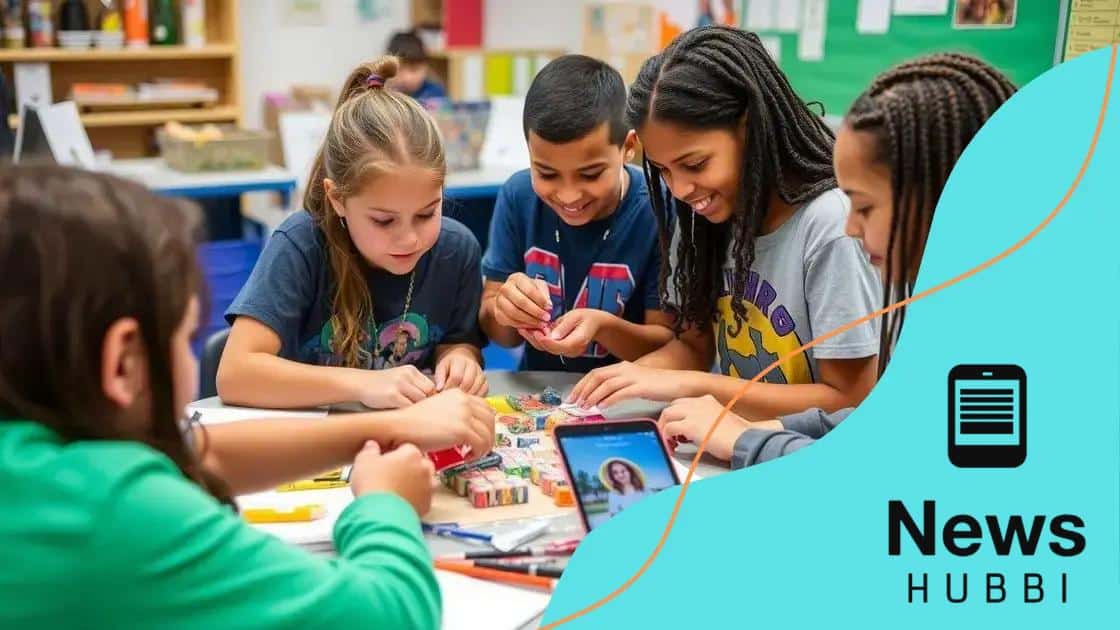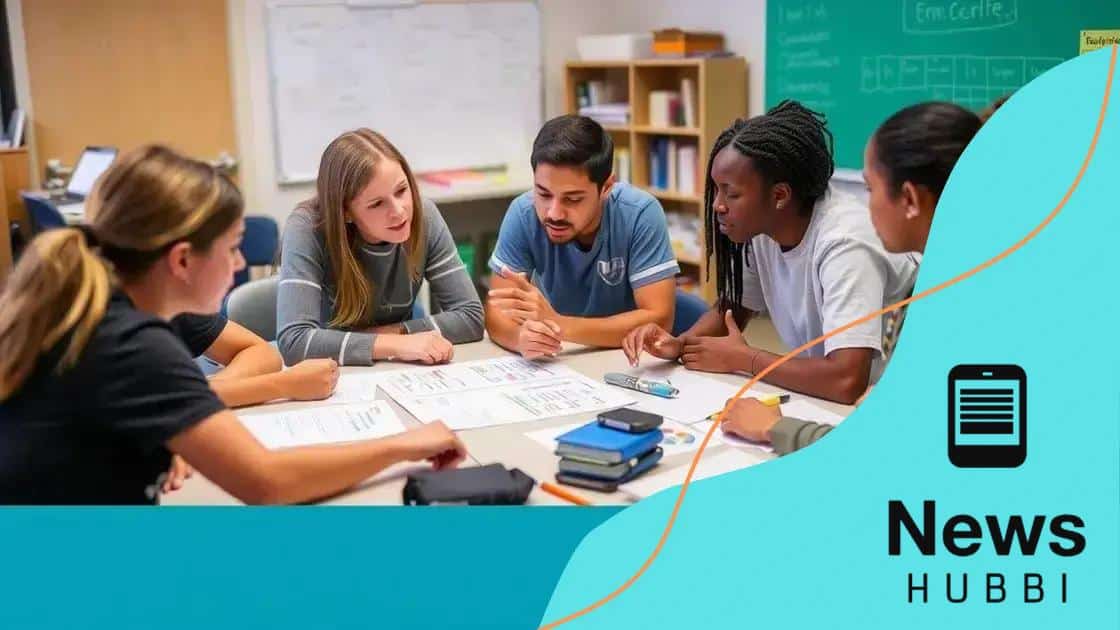The benefits of project-based learning in higher education

Anúncios
The benefits of project-based learning in higher education include enhanced engagement, improved collaboration, and the development of critical thinking skills through hands-on, real-world projects that prepare students for future challenges.
The benefits of project-based learning in higher education are profound. Imagine students diving into real-world projects that spark their interest and enhance their skills. Isn’t it exciting to think about how this approach can transform traditional learning?
Anúncios
Understanding project-based learning
Understanding project-based learning involves grasping how students actively engage in their education through real-world projects. This learning method encourages creativity and collaboration, enabling students to acquire skills that are essential for their future careers.
What is Project-Based Learning?
Project-based learning (PBL) is an instructional approach where students learn by engaging in projects. These projects can range from simple tasks to complex problems that require extensive research. By diving into these projects, students develop a deeper understanding of the subject matter.
Key Features of Project-Based Learning
- Real-world relevance: Projects reflect actual challenges and situations.
- Student-driven exploration: Learners take charge of their learning process.
- Collaboration: Students work together, fostering teamwork and communication.
- Critical thinking: PBL encourages students to analyze and solve problems creatively.
As students participate in projects, they practice important skills such as planning, organization, and time management. They learn to ask questions, seek answers, and reflect on their work. This hands-on experience enables them to connect theory with practice, making learning more meaningful.
Anúncios
Moreover, project-based learning fosters a sense of ownership. Students feel empowered when they can contribute their ideas and see their efforts leading to tangible outcomes. This autonomy boosts motivation and encourages a lifelong love for learning.
In addition to enhancing academic skills, PBL also promotes essential life skills. Students gain experience in leadership, communication, and problem-solving, preparing them for future challenges.
Key advantages for students

Project-based learning offers several key advantages for students that enhance their educational experience. By engaging in hands-on projects, students not only grasp theoretical concepts but also apply them in real-world scenarios. This method encourages a deeper understanding and retains knowledge more effectively.
Enhanced Learning Retention
When students participate in projects, they often retain information better than through traditional lectures. The process of actively engaging with the materials solidifies their understanding. Furthermore, working on a project means they get to revisit concepts multiple times, reinforcing their learning.
Development of Critical Skills
- Collaboration: Students learn to work effectively with peers, sharing ideas and responsibilities.
- Problem-solving: Encountering challenges within projects helps develop analytical thinking.
- Communication: Presenting projects fosters public speaking and written communication skills.
- Time management: Meeting deadlines teaches students to manage their schedules and set priorities.
These skills are essential for success in both academic and professional settings. By participating in project-based learning, students prepare themselves for future challenges in a meaningful way. Moreover, they become more independent learners, taking ownership of their education.
Engaging in real-world scenarios also instills a sense of purpose. Students see the relevance of their education, making learning more enjoyable and fulfilling. This leads to increased motivation and enthusiasm for school.
How project-based learning fosters collaboration
How project-based learning fosters collaboration is essential in today’s educational approach. Students working together on projects learn to communicate effectively and build teamwork skills. This collaborative environment not only enhances their learning experience but also prepares them for real-world situations.
Creating a Collaborative Environment
In project-based learning, students are often placed in groups. This setup encourages them to share ideas and solve problems collectively. They learn to value each other’s contributions, fostering mutual respect.
Benefits of Collaboration
- Improved Communication: Students practice articulating their thoughts clearly, which is crucial for future careers.
- Conflict Resolution: Working together helps students navigate disagreements and find compromises.
- Diverse Perspectives: Collaboration introduces varied viewpoints, enriching the project’s overall quality.
- Shared Responsibility: Group projects teach students to depend on one another, building a sense of accountability.
As students collaborate, they also learn how to delegate tasks and recognize individual strengths within their group. This process increases their willingness to engage with others and share the workload equally. It becomes a powerful learning experience where each member grows through interaction.
The real-world applicability of these skills cannot be overstated. Employers often seek individuals who can work well in teams. Therefore, by learning through collaboration, students are better equipped for the workforce, which values cooperation.
Impact on critical thinking skills

The impact on critical thinking skills in project-based learning is profound. This educational approach encourages students to ask questions, analyze information, and evaluate solutions. Unlike traditional learning, which often focuses on rote memorization, project-based learning promotes deeper understanding and application of knowledge.
Encouraging Inquiry
In a project-based environment, students are faced with real-world problems that require investigation. They learn to identify challenges and develop hypotheses. This process fosters an inquiry-based mindset, encouraging them to dig deeper and seek evidence for their solutions.
Skills Developed through PBL
- Analysis: Students assess various perspectives and data before making decisions.
- Synthesis: They combine different ideas to form new concepts or products.
- Evaluation: Students critique their own work and the work of others, learning to provide constructive feedback.
- Reflection: Through reflection, students consider what they learned and how it can be applied in future situations.
By engaging in projects, students sharpen their problem-solving abilities. They learn that there are often multiple solutions to a single problem and that evaluating these options critically is essential. This skill is highly beneficial, as it prepares them for diverse scenarios in both academic and professional environments.
Additionally, the collaborative nature of project-based learning enhances critical thinking. Working with peers exposes students to different viewpoints, challenging their assumptions and encouraging them to think more critically. This interaction leads to a richer understanding of the subject matter and the development of valuable companions such as respect for diversity of thought.
Implementing project-based learning in curricula
Implementing project-based learning in curricula can transform the educational experience for students. This method encourages engagement and fosters critical skills by integrating hands-on projects into the learning process. To effectively implement project-based learning, several key strategies should be considered.
Steps for Implementation
The first step involves aligning projects with learning objectives. Educators should select projects that complement the curriculum and essential skills students must acquire. Once the projects are defined, planning is essential to ensure that timelines and resources are well organized.
Key Considerations
- Student Choice: Allowing students to choose from various project options increases their interest and investment in the outcome.
- Real-World Connections: Projects should relate to real-life issues, making learning relevant and meaningful.
- Collaborative Learning: Encourage group work to foster teamwork and communication skills.
- Continuous Feedback: Provide ongoing support and feedback throughout the project to guide students in their learning process.
As projects unfold, it’s important to incorporate reflection periods. Students can assess their work and learn what strategies were effective. Reflection encourages deeper learning, allowing them to connect their experiences with the concepts taught in class.
Furthermore, integrating technology can enhance project-based learning. Utilizing digital tools for research, collaboration, and presentation can significantly improve students’ engagement and skill development. This approach not only makes projects more interactive but also prepares students for a tech-driven world.
FAQ – Frequently Asked Questions about Project-Based Learning in Higher Education
What is project-based learning?
Project-based learning is an instructional method where students engage in real-world projects to gain knowledge and skills through hands-on experience.
How does project-based learning enhance student engagement?
It enhances engagement by involving students in active learning, where they explore topics that interest them and apply knowledge to real-life situations.
What skills does project-based learning develop?
It develops critical thinking, collaboration, communication, and problem-solving skills, which are essential for success in both academic and professional settings.
How can educators integrate project-based learning into their curricula?
Educators can integrate project-based learning by selecting relevant projects, allowing student choice, and incorporating technology to enhance research and collaboration.





